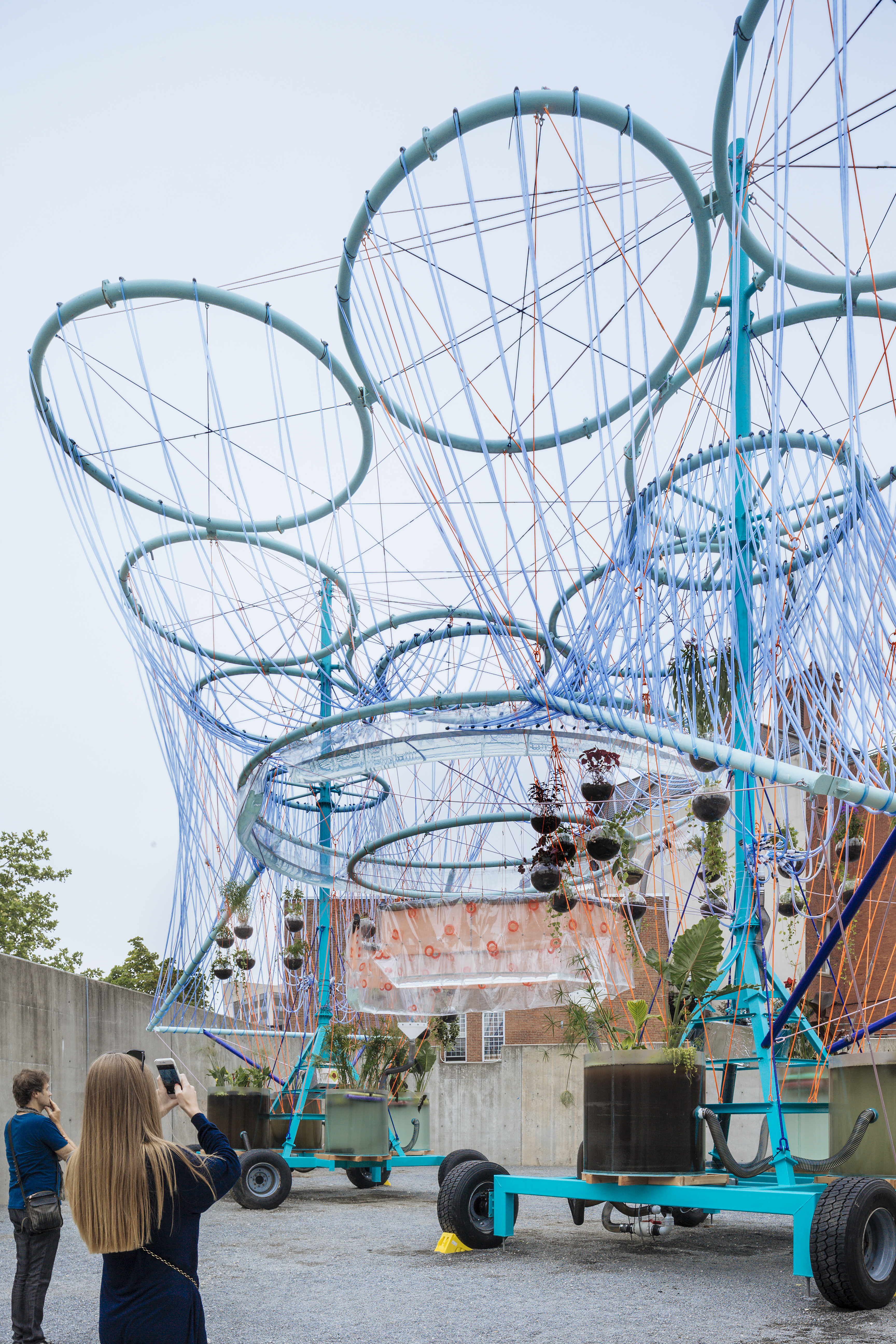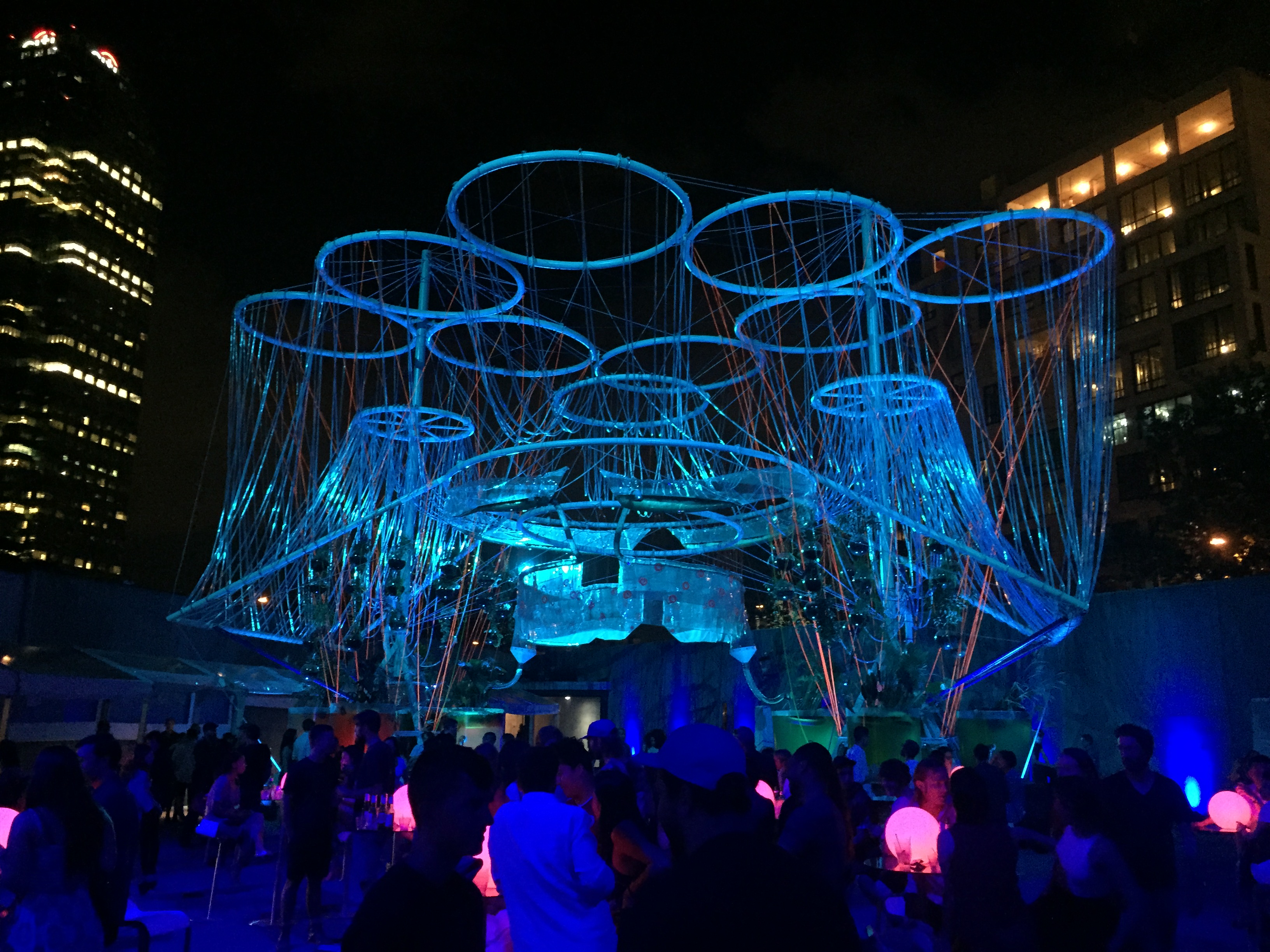Leaky Architectures
Andrés Jaque in conversation with Kareem Obey
The contructed works of Andrés Jaque are where science fiction, sewage systems, and urban politics collide as architectural practice. These are devices that are always doing: they are leaking, rolling, pumping, and feeding, often all at once. Jaque is the founding principal of the Office for Political Innovation (OFFPOLINN), a Madrid- and New York-based practice who conceive of architecture as “the way different entities negotiate their coexistence.” Herein, he speaks with Seattle-based architectural designer Kareem Obey who seeks out the leaky and fluid qualities of OFFPOLINN’s body of work.
Read more on constellations, leaky devices, and the gay hookup app Grindr below.



Kareem Obey:
The works of COSMO, Different Kinds of Water Pouring Into a Swimming Pool ![]()
![]() and Rolling House for the Rolling Society
and Rolling House for the Rolling Society ![]() propose, are implied to be, or are directly referred to as “devices”. Given the power of words we use (and don’t use) to understand and actualize our lived realities, what informs your decision to describe elements of these works as “devices”?
propose, are implied to be, or are directly referred to as “devices”. Given the power of words we use (and don’t use) to understand and actualize our lived realities, what informs your decision to describe elements of these works as “devices”?



Andrés
Jaque:
Jaque:
For me
architecture is not about autonomous objects. I understand architecture as
society being intervened. It is the way specific socio-environmental milieus
are affected, what I would call architecture. So, from this perspective, it
does not make sense talking about architectural objects. What is then important
is the way different entities negotiate their coexistence.
Foucault’s notion of dispositive or device or Agamben’s apparatus are much more useful terms; since they characterize technological entities (and therefore by extension architectural, being architecture a form of technology) as participating socially, as plural, multiple and transscalar.
Foucault’s notion of dispositive or device or Agamben’s apparatus are much more useful terms; since they characterize technological entities (and therefore by extension architectural, being architecture a form of technology) as participating socially, as plural, multiple and transscalar.
KO:
Given the
implication of relational power within the label “devices”,
what are the power dynamics that these devices act in
response to?
AJ:
I see them as
actors that introduce dissidence in transterritorial mediums, run by high
concentrations of power. COSMO is a device of dissidence, that provides a
demonstrative experience of how New Yorkers can coexist with the toxicity
and waste their daily life is associated with, instead of having it sent to
distant poorer states.
Architecture has the capacity to create spaces of disobedience and dissidence. Milieus where disalignment is possible. That is the way we operate. In the Office for Political Innovation, architecture is the invention of techno-social dissidence.
Architecture has the capacity to create spaces of disobedience and dissidence. Milieus where disalignment is possible. That is the way we operate. In the Office for Political Innovation, architecture is the invention of techno-social dissidence.

Rolling House for the Rolling Society, 2009
KO:
Much of your work exposes elements of the city that are present but
are often invisible or overlooked, including underground plumbing, sewage, and
drainage. What connection can you draw between the way that we as individuals
or as a society relate to hidden infrastructures in the construction of both
our physical and social environments?
AJ:
We live in a
world where realism struggles to fight collective alienating delusion. We are
not interested in speculating about the future, but rather in rendering the
present real; in densifying its load of realism. This is to say its criticality.
Projects like Reggio School or Escarvox ![]() are thought of as strategies to
multiply the layers of realism specific mediums are loaded.
are thought of as strategies to
multiply the layers of realism specific mediums are loaded.

KO:
I can’t help
but notice a "leaky" quality present across these works.
Whether it is a leakiness across literal or implied scales present in COSMO, a leakiness in identity
suggested in Different Kinds of Water Pouring Into a Swimming Pool ![]() and Rolling House for the Rolling Society and of course in the literal sense too - this collection of work is rather wet.
What role does this wetness or, more specifically, leakiness play in
these works for you?
and Rolling House for the Rolling Society and of course in the literal sense too - this collection of work is rather wet.
What role does this wetness or, more specifically, leakiness play in
these works for you?

AJ:
Politics are often embedded in the way architectural entities expand and
concrete across scales and mediums. Architecture is not contained in concrete
objects. Architecture operates as relational states where broad constellations
of entities negotiate their relationships and interdependencies. Now
architecture is no longer an objectual practice, but rather a techno-social
relational practice.
KO:
Speaking of power and leakiness, OFFPOLINN engages with what the limits
of the practice of architecture can be and how it can more explicitly
engage with (and subvert) the normativising rules/structures of our lived
experiences. In doing so, OFFPOLINN seems to enact a model of
actively queering architecture. To what extent would you say ideas of
queerness, understood as destabilizing a rigid set of identities or ways of
being, are at play in these works?
AJ:
There is no
escape from the domain of capitalism or the associated environmental crisis,
but alternatives coexist with them. It is possible and needed to empower and
multiply the possibility to enact alternative. Our work often consist on
developing forms of design activism that attempt to reinvent our medium as
loaded with multiplied modes of dissidence. The architecture of OFFPOLINN is
focused on multiplying the existing forms of dissidence.
![]()
Rolling House for the Rolling Society, 2009

Rolling House for the Rolling Society, 2009
KO:
How can leakiness play a role in the alternative forms of occupation/engagement with space? Does it at all?
AJ:
By studding the source of Berlusconi’s power, we discover that
contemporary power comes from the capacity for architecture to unfold as
transmedium technologies. This is to say that the architecture that has the
capacity to introduce changes in the techno-societies we live by requires to
coordinate what happens on and offline and what happens at the large scale of
mines with what happens in bodies. This is what we also found in projects such
as Intimate Strangers, ![]() the research project that we developed to back track the
way the gay hook-up app Grindr, and other locative media operated.
the research project that we developed to back track the
way the gay hook-up app Grindr, and other locative media operated.






Pornified Homes, 2016
KO:
The fluids of these works refer directly or indirectly to the body, our
proprioception. How do you see the body and its relation to its
own wetness in these works?
AJ:
In a place like
New York, high-end apartments, genetically engineered bodies and the massive
transformation of the Marcellus Shale’s mineral resources are all part of a
massive architectural design that started to be developed in the 1980s and that
is now becoming effective. This is what we reconstructed in our project Sex and the So-Called City![]() . A new type of medium not urban, nor rural, that has
installed a regime of Highendcracy, that situate human and non-human in
overlapping segregated milieus.
. A new type of medium not urban, nor rural, that has
installed a regime of Highendcracy, that situate human and non-human in
overlapping segregated milieus.

KO:
In the case of COSMO revealing the constellation of New York City’s
sewer system, I can’t help but think of David Gissen’s work Subnatures. Gissen's discussion
of “dankness” elaborates on the idea that sewers and basements
grew in parallel with surface level urbanization, and that dankness connotes
ideas of otherness in the urban context. Contrarily, COSMO presents a
distinctly pristine, non-dank space for its occupants. Was it
purposeful to create this dissonance/reorientation of the sewage system?
AJ:
Yes. Not only
of the sewage system, because it does not operate as an autonomous system, but
to contribute to recompose the whole ecosystem of material power in the larger
region affected by New York societies
.
![]()
COSMO, 2015
.

COSMO, 2015